What Does Blitz Mean In Football? A blitz in football is a defensive strategy where five or more defensive players rush the quarterback, aiming to disrupt the play. At CAUHOI2025.UK.COM, we provide in-depth explanations of football terms and strategies. Explore the nuances of defensive schemes, offensive tactics, and football terminology to enhance your understanding of the game.
1. Understanding the Blitz in Football
In American football, a blitz is a defensive play where the defense sends an unusually high number of players to rush the opposing quarterback. Instead of the typical four rushers, a blitz involves five or more players attempting to sack the quarterback or disrupt the passing play. This aggressive tactic aims to pressure the quarterback and force quick decisions or turnovers.
1.1 Core Objective of a Blitz
The primary goal of a blitz is to pressure the quarterback. This pressure can lead to several positive outcomes for the defense:
- Sack: Bringing the quarterback down behind the line of scrimmage.
- Hurried Throw: Forcing the quarterback to release the ball before they are ready, often leading to inaccurate passes.
- Turnover: Causing a fumble or interception due to the quarterback’s hurried decision-making.
1.2 The Standard Pass Rush
Typically, a football team will send about four players to rush the quarterback on most plays. These usually include defensive tackles and defensive ends, whose main goal is to get past the offensive line and pressure the quarterback to disrupt the play.
1.3 Risk vs. Reward
While a blitz can be highly effective, it also carries significant risk. By sending more players to rush, the defense leaves fewer players in coverage, making them vulnerable to quick passes or running plays if the blitz fails to reach the quarterback in time. According to a study by ESPN Stats & Info, blitzing increases the chance of a sack but also increases the chance of a big play for the offense if the quarterback can evade the rush.
2. The Nuances of Blitzing
Blitzing isn’t just about sending extra players; it’s a strategic decision that requires careful planning and execution.
2.1 Number of Blitzers
A blitz typically involves sending five to seven defenders, but sometimes as many as eight players can rush the quarterback at the snap. Blitzing involves risk because it leaves fewer defenders to cover the rest of the field. The more players sent towards the quarterback, the fewer defenders remain to cover receivers and other passing options.
2.2 Mobile Quarterbacks and the Blitz
Mobile quarterbacks can evade blitzes using their speed and agility, neutralizing the effectiveness of the rush. This mobility forces defensive coordinators to adjust their blitzing strategies to account for the quarterback’s ability to escape pressure.
2.3 The Importance of Timing
A well-timed blitz can be devastating to the opposing team, creating turnovers and disrupting the offensive rhythm. The element of surprise is crucial, as a blitz that the offense anticipates can be easily countered.
3. The Role of the Defensive Coordinator
The defensive coordinator is responsible for designing and calling the defensive plays, including blitzes. This role requires a deep understanding of the game and the ability to analyze the opponent’s tendencies.
3.1 Responsibilities of the Defensive Coordinator
- Game Preparation: Analyzing the opponent’s offensive schemes and identifying weaknesses.
- Play Calling: Choosing the right defensive plays to counter the offense.
- Player Guidance: Preparing each position group for game day.
3.2 Outsmarting the Offense
The defensive coordinator aims to outsmart the offense by using different plays to defend the run, defend the pass, and pressure the quarterback. The ultimate goal is to get the defense off the field as quickly as possible, allowing the offense to score.
4. Common Types of Blitzes
There are several types of blitzes, each with its own strengths and weaknesses. These include the zone blitz, safety blitz, cornerback blitz, zero blitz, and run blitz.
4.1 Zone Blitz
A zone blitz involves a linebacker blitzing in place of a defensive lineman or edge rusher, who then drops back into coverage.
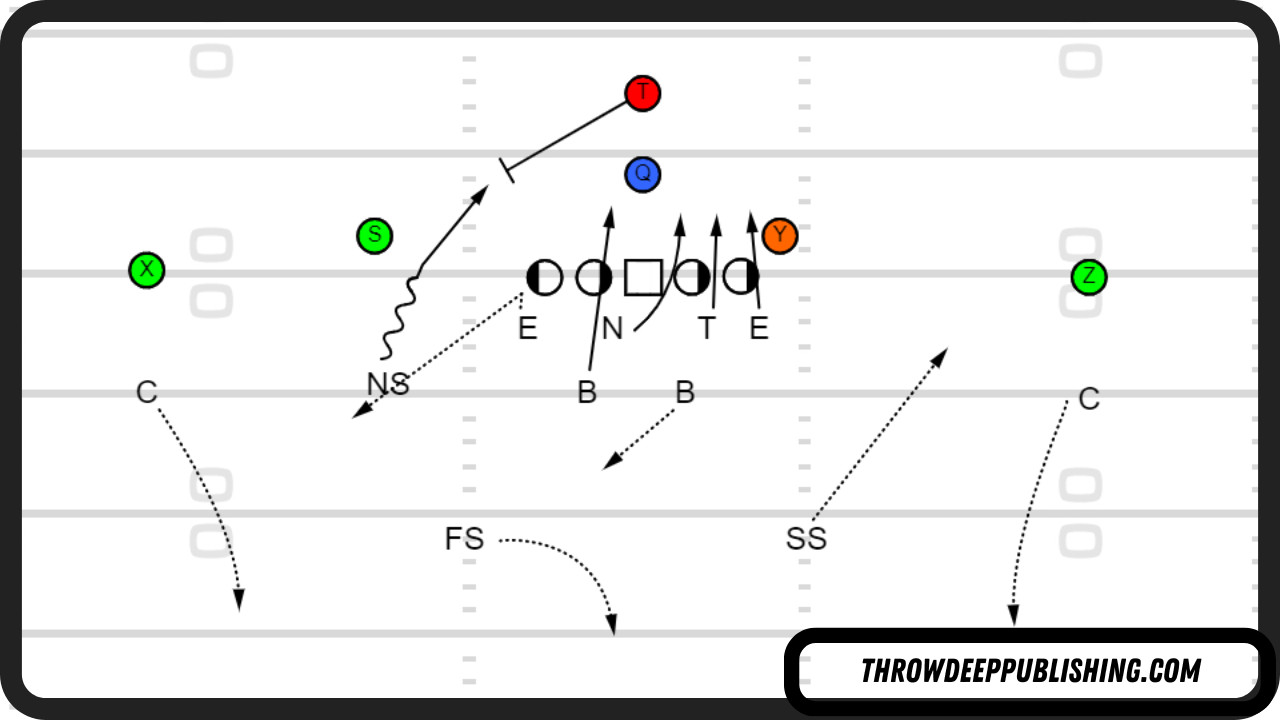 Zone Blitz
Zone Blitz
- Objective: To confuse the offensive line and disrupt blocking assignments.
- Benefit: Can trick the offense into thinking more defenders are blitzing than actually are, leading to more defenders covering fewer receivers.
4.2 Safety Blitz
In a safety blitz, one of the safeties comes down to blitz with the other defenders.
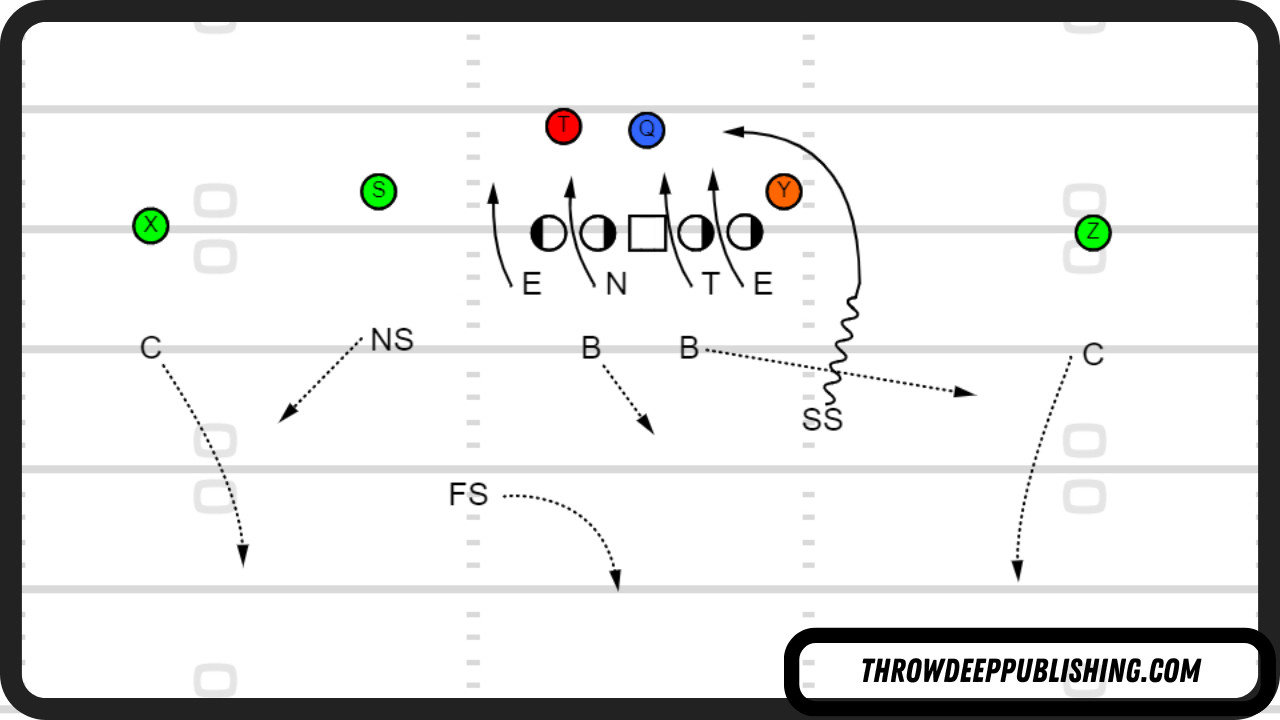 Safety Blitz
Safety Blitz
- Risk: Leaves a gap open behind the safety, which a quarterback can exploit for a big play.
- Advantage: Adds an element of surprise that can throw off the offense.
4.3 Cornerback Blitz
A cornerback blitz is similar to a safety blitz, but a cornerback replaces the blitzing safety.
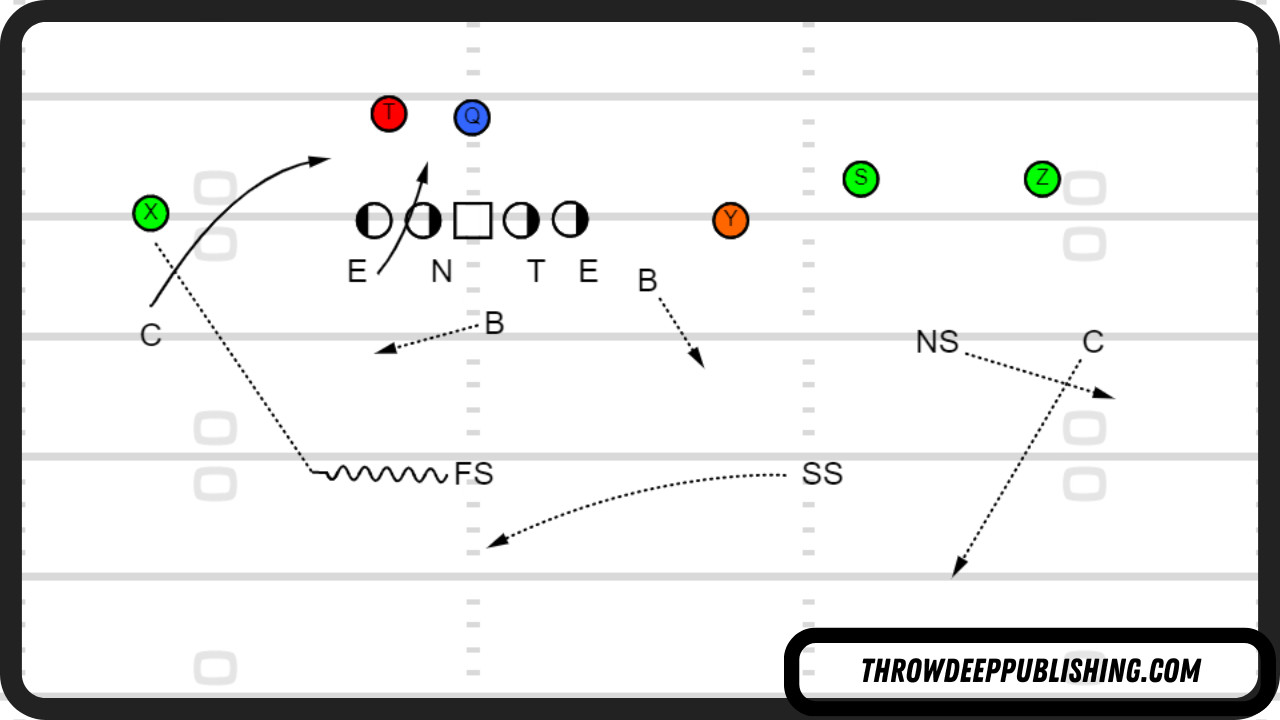 Corner Blitz
Corner Blitz
- Objective: To pressure the quarterback quickly before he can find the open receiver.
- Benefit: Creates an element of surprise that can disrupt the offensive timing.
4.4 Zero Blitz
A zero blitz is the riskiest of all, leaving no deep safety to cover the deep section of the field.
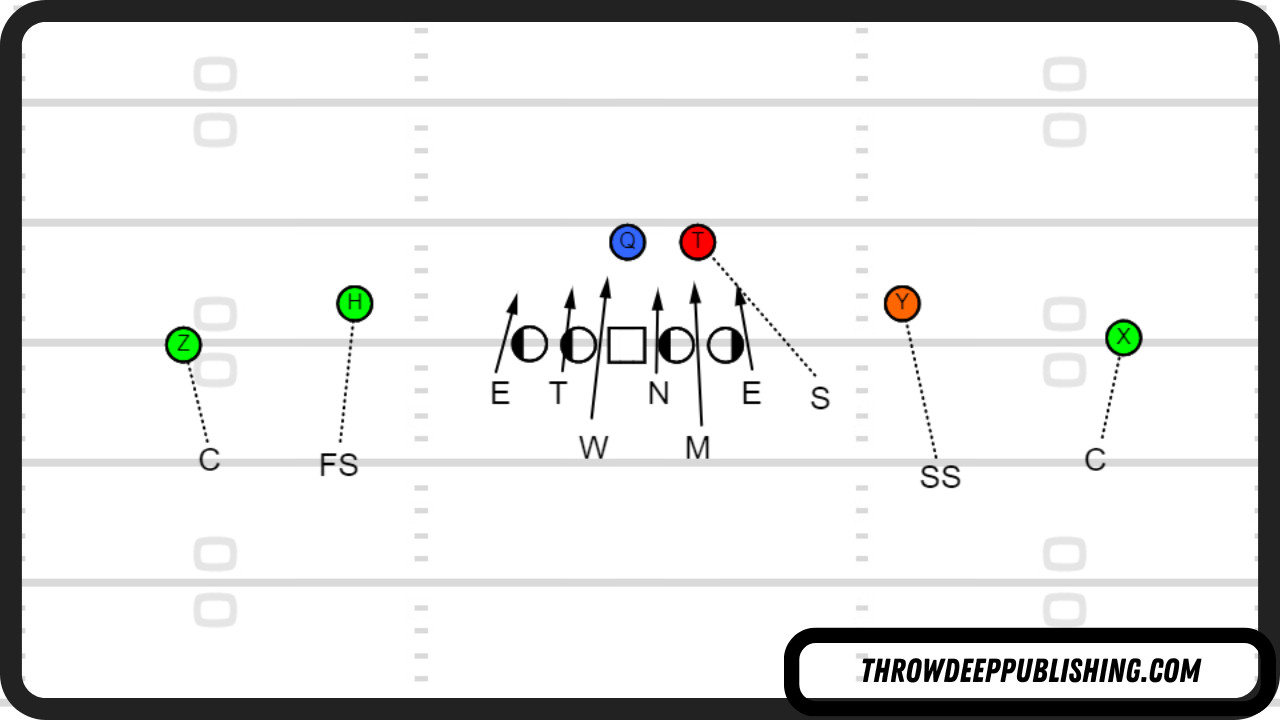 Cover Zero Blitz
Cover Zero Blitz
- Use Case: Typically used when the defense is almost certain the offense will run the football.
- Risk: Highly vulnerable to exploitation if the offense can throw the ball in time.
4.5 Run Blitz
A run blitz is designed to disrupt the run game by sending multiple defenders to the point of attack.
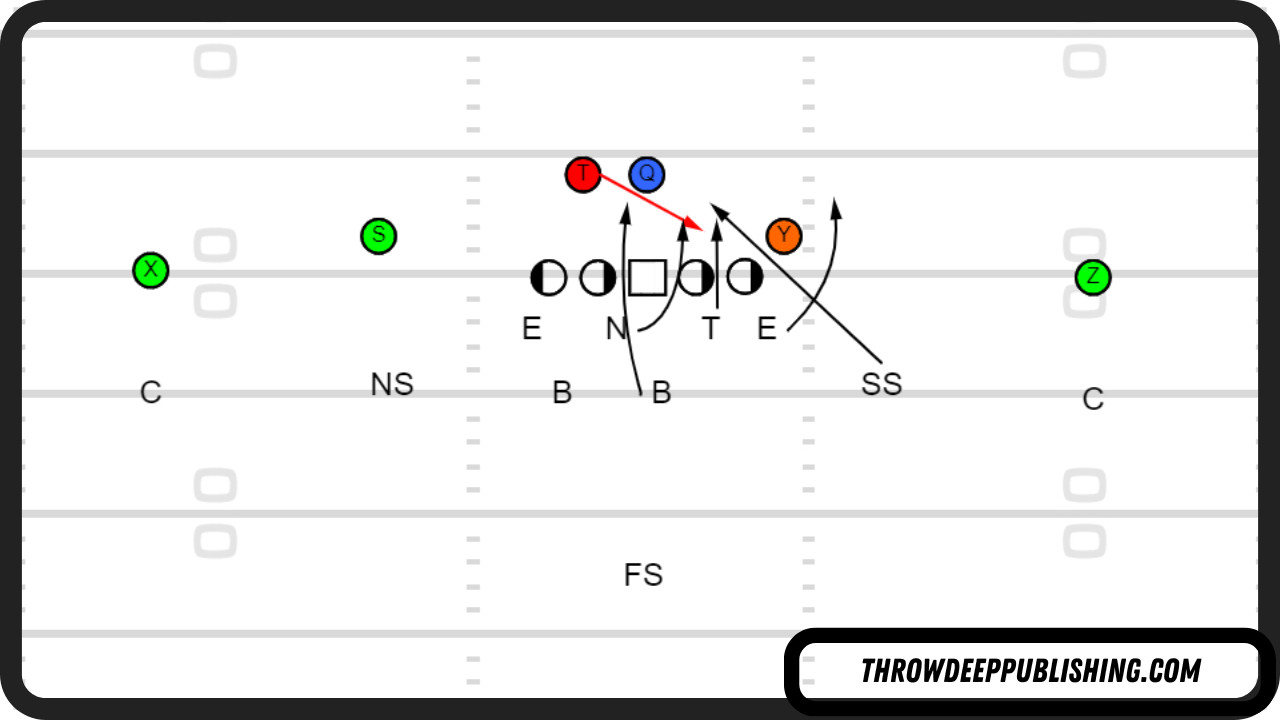 Run Blitz
Run Blitz
- Objective: To stop the runner before they can gain significant yardage.
- Benefit: Effective when the defense anticipates a run play.
5. How Offenses Counter the Blitz
To effectively counter a blitz, the offense needs to get the ball out of the quarterback’s hands quickly.
5.1 Quick Passes
If a quarterback identifies a blitz before the snap, they can throw to an open receiver before the defense can reach them.
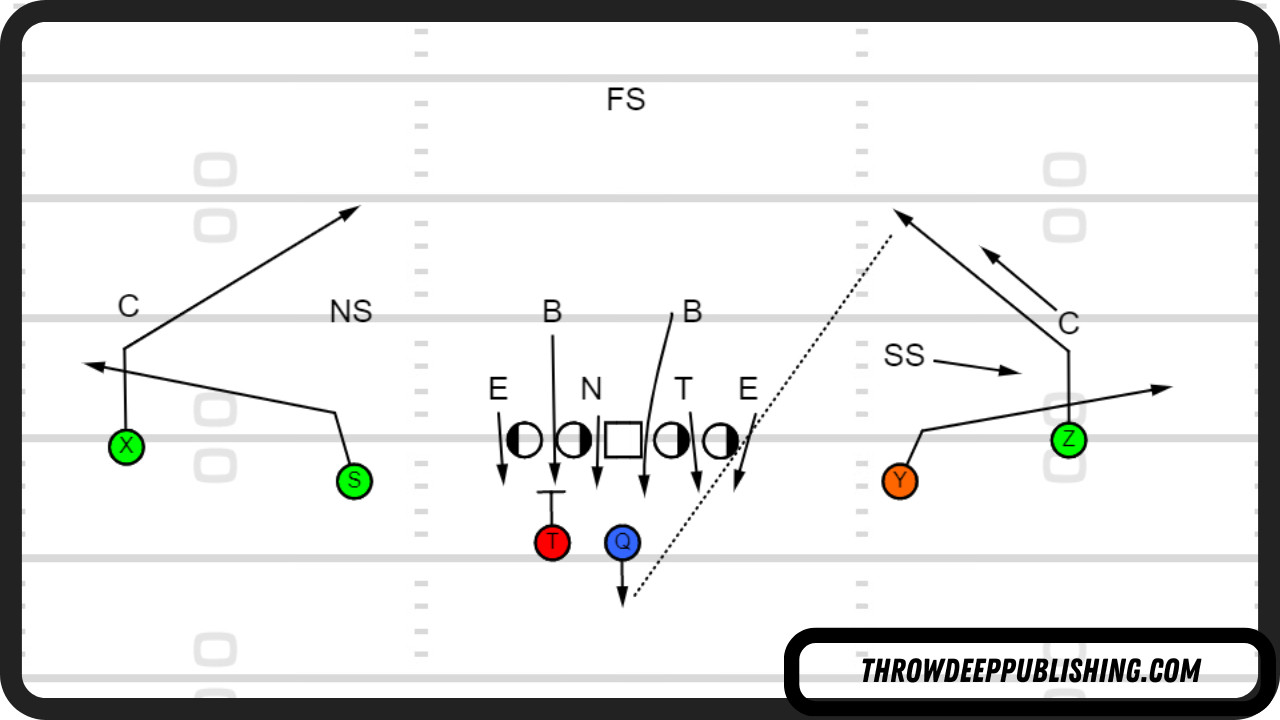 Quick Pass
Quick Pass
- Key Target: The running back, who is often the closest player to the quarterback.
- Benefit: Can result in big plays if executed correctly.
5.2 Mobile Quarterbacks
A mobile quarterback can evade oncoming defenders and create opportunities for big gains.
5.3 Max Protection
An offense can use a max protection scheme, where additional players stay back to block instead of running downfield.
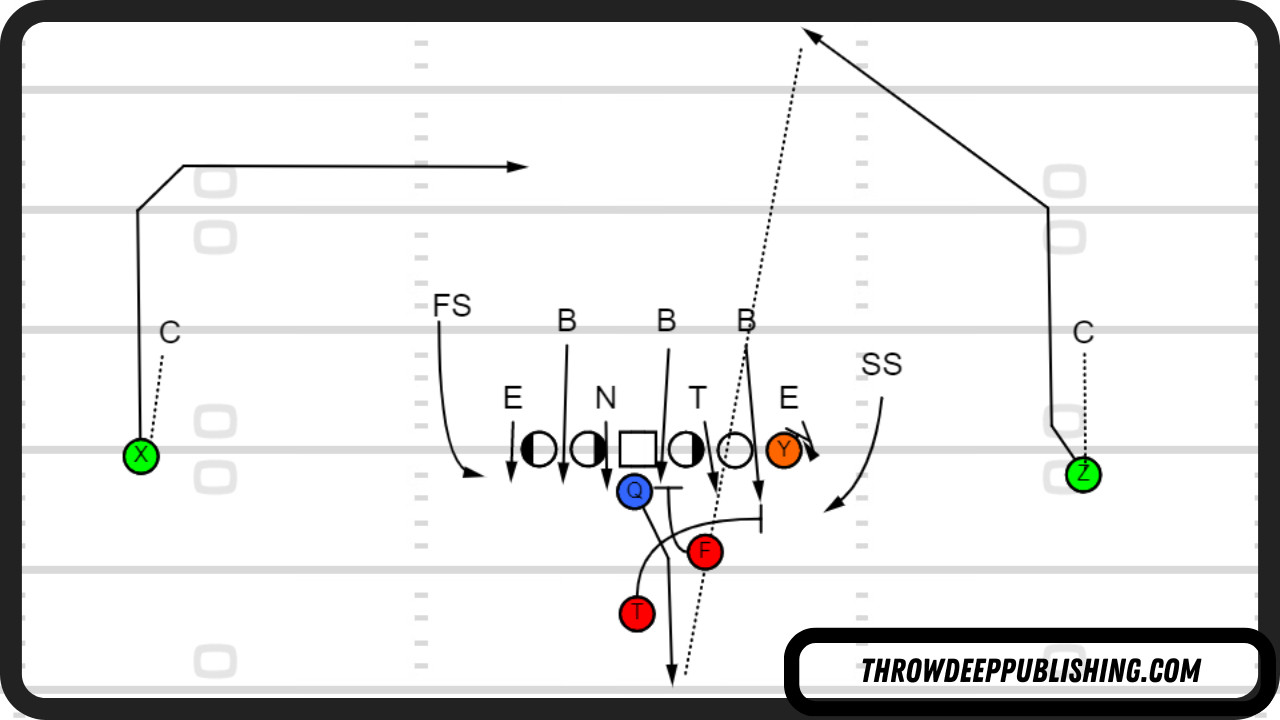 Max Protection Pass
Max Protection Pass
- Objective: To give the quarterback more time to find an open receiver.
- Benefit: Slows down the blitz and allows for potential big plays downfield.
6. The Strategic Importance of the Blitz
The blitz is a high-risk, high-reward play that can significantly impact the outcome of a football game. Understanding its nuances and variations is essential for both players and fans.
6.1 Disrupting Offensive Timing
Blitzes can disrupt the timing of an offensive play, cause confusion among the offensive line, and disrupt the run game. According to a study by Pro Football Focus (PFF), successful blitzes often lead to lower offensive efficiency and increased turnover rates.
6.2 Creating Chaos and Confusion
A well-executed blitz can create chaos and confusion, forcing the quarterback to make quick decisions under pressure.
6.3 Blowing Up the Run Game
When used correctly, a blitz can effectively stop the run, forcing the offense into unfavorable passing situations.
7. Key Considerations for Effective Blitzing
For a blitz to be effective, several factors must be considered:
- Opponent Tendencies: Understanding the opponent’s offensive tendencies and weaknesses.
- Personnel Matchups: Utilizing players with the right skills for specific blitzing roles.
- Timing and Disguise: Executing the blitz at the right moment and disguising the intent to confuse the offense.
8. The Evolution of the Blitz
The blitz has evolved significantly over the years, with defensive coordinators constantly innovating to stay ahead of offensive strategies.
8.1 Historical Context
The concept of the blitz has been around for decades, but its implementation has changed with the evolution of the game. Early forms of the blitz were more straightforward, focusing on overwhelming the offensive line with sheer numbers.
8.2 Modern Blitzing Strategies
Today’s blitzing strategies are more sophisticated, involving complex schemes and player assignments. Defensive coordinators use a variety of blitz packages to keep offenses guessing and create favorable matchups.
8.3 The Impact of Rule Changes
Rule changes designed to protect quarterbacks have also influenced blitzing strategies. Defensive coordinators must now balance the need to pressure the quarterback with the risk of penalties for roughing the passer.
9. Notable Defensive Coordinators Known for Their Blitzing Prowess
Several defensive coordinators have made a name for themselves with their innovative and aggressive blitzing schemes.
9.1 Dick LeBeau
Known for his “Steel Curtain” defenses in Pittsburgh, LeBeau was a master of the zone blitz, confusing offenses with unpredictable pressure.
9.2 Bill Belichick
Belichick’s defenses in New England have been known for their adaptability and ability to exploit offensive weaknesses with well-timed blitzes.
9.3 Gregg Williams
Williams’ aggressive and risk-taking approach to blitzing has made him one of the most polarizing figures in the NFL.
10. How to Improve Your Understanding of Football Strategies
Understanding football strategies like the blitz can greatly enhance your enjoyment of the game. Here are some ways to deepen your knowledge:
10.1 Watch Games Critically
Pay attention to the defensive formations and player movements before the snap. Try to anticipate whether a blitz is coming and how the offense might react.
10.2 Study Film
Many resources are available online that break down game film and explain the nuances of different plays and strategies.
10.3 Read Football Analysis
Follow reputable football analysts and websites that provide in-depth coverage of the game.
11. Common Mistakes to Avoid When Analyzing Blitzes
When analyzing blitzes, avoid these common mistakes:
- Overlooking Offensive Adjustments: Failing to recognize how the offense is adjusting to the blitz.
- Ignoring Coverage Schemes: Focusing solely on the pass rush without considering the coverage schemes behind it.
- Assuming Predictability: Thinking that a team will always blitz in certain situations.
12. Real-World Examples of Game-Changing Blitzes
Throughout NFL history, there have been numerous examples of blitzes that changed the course of a game.
12.1 Super Bowl XLII
The New York Giants’ pass rush, including several well-timed blitzes, disrupted Tom Brady and the New England Patriots’ offense, leading to a stunning upset.
12.2 The “Immaculate Reception” Game
In a 1972 playoff game, the Pittsburgh Steelers’ aggressive blitzing helped set up the famous “Immaculate Reception” play that propelled them to victory.
13. The Future of Blitzing in Football
As football continues to evolve, the blitz will likely remain a key component of defensive strategy.
13.1 Increased Emphasis on Analytics
Teams will increasingly use analytics to identify optimal blitzing opportunities and matchups.
13.2 More Sophisticated Schemes
Defensive coordinators will continue to develop more sophisticated blitzing schemes to stay ahead of evolving offensive strategies.
13.3 Greater Emphasis on Player Versatility
Players who can effectively rush the passer and drop into coverage will become increasingly valuable.
14. Statistics on the Frequency of Blitzing
The frequency of blitzing varies widely depending on the team, coach, and game situation.
14.1 NFL Blitzing Rates
According to NFL data, some teams blitz on as little as 20% of their defensive snaps, while others blitz on over 40% of snaps.
14.2 Impact on Defensive Performance
Teams that blitz more frequently tend to have higher sack rates but also allow more passing yards.
14.3 Factors Influencing Blitzing Decisions
Coaches consider factors such as the opponent’s quarterback, offensive line, and down-and-distance situations when deciding whether to blitz.
15. Essential Skills for Executing a Successful Blitz
Executing a successful blitz requires a combination of physical and mental skills.
15.1 Speed and Agility
Blitzing players must be quick and agile to get past blockers and pressure the quarterback.
15.2 Strength and Power
The ability to overpower blockers is also essential for a successful blitz.
15.3 Football IQ
Understanding the offensive scheme and anticipating the quarterback’s movements are crucial for executing a blitz effectively.
16. The Psychological Impact of Blitzing
Blitzing can have a significant psychological impact on both the offense and the defense.
16.1 On the Offense
Constant blitzing can create a sense of unease and pressure on the quarterback, leading to mistakes and poor decision-making.
16.2 On the Defense
A successful blitz can boost the defense’s confidence and create momentum, leading to better overall performance.
16.3 The Role of Fear
The threat of a blitz can create a sense of fear and uncertainty on the offense, making them more likely to make mistakes.
17. Why Understanding the Blitz Matters for Football Fans
Understanding the blitz is essential for football fans who want to fully appreciate the complexities and nuances of the game.
17.1 Enhanced Viewing Experience
Knowing when and why a team is blitzing can greatly enhance your viewing experience and allow you to appreciate the strategic battles between the offense and defense.
17.2 Deeper Appreciation for Coaching Decisions
Understanding the blitz allows you to better appreciate the decisions made by coaches and coordinators.
17.3 Better Understanding of Player Performance
Knowing the blitz helps you to better understand the performance of individual players, both on the offensive and defensive sides of the ball.
18. Common Misconceptions About the Blitz
There are several common misconceptions about the blitz that are important to dispel.
18.1 Blitzing Always Works
While a blitz can be effective, it is not a guaranteed strategy for success. A poorly executed blitz can leave the defense vulnerable to big plays.
18.2 Blitzing Is Always Aggressive
While blitzing is generally considered an aggressive strategy, it can also be used as a way to confuse the offense and force them into making mistakes.
18.3 Only Linebackers Blitz
While linebackers are often involved in blitzes, defensive backs and even defensive linemen can also be used to blitz the quarterback.
19. Learning Resources for Further Study
There are many resources available for those who want to learn more about the blitz and other football strategies.
19.1 Books
Several books offer in-depth coverage of football strategy, including “Blood, Sweat, and Chalk: The Ultimate Football Playbook” by Tim Layden.
19.2 Websites
Websites like Pro Football Focus (PFF) and ESPN provide detailed analysis of football games and strategies.
19.3 Coaching Clinics
Attending coaching clinics can provide valuable insights into the latest football strategies and techniques.
20. Key Takeaways About the Blitz
The blitz is a complex and dynamic strategy that plays a key role in modern football.
20.1 Strategic Importance
The blitz is a high-risk, high-reward play that can significantly impact the outcome of a game.
20.2 Variations
There are many different types of blitzes, each with its own strengths and weaknesses.
20.3 Countermeasures
Offenses can employ various countermeasures to neutralize the effectiveness of a blitz.
21. FAQ: Understanding the Blitz
Here are some frequently asked questions about the blitz in football.
Q1: What is a soft blitz?
A soft blitz typically involves sending only five rushers, but with a focus on deception and timing rather than overwhelming pressure.
Q2: How does a team know when to blitz?
Coaches analyze game situations, opponent tendencies, and personnel matchups to determine the best time to blitz.
Q3: What is the difference between a blitz and a stunt?
A blitz involves sending extra rushers, while a stunt involves the defensive line executing pre-planned movements to confuse blockers.
Q4: Can a blitz be called on every play?
While a team could theoretically blitz on every play, it would likely be ineffective due to the high risk of leaving the defense vulnerable.
Q5: Who is responsible for calling the blitz?
The defensive coordinator is typically responsible for calling the blitz, but some coaches allow players to make adjustments at the line of scrimmage.
Q6: What is the most common type of blitz?
The most common type of blitz is the zone blitz, which allows the defense to maintain coverage while still applying pressure.
Q7: How does the quarterback identify a blitz?
Quarterbacks look for pre-snap indicators such as defensive alignment, player positioning, and body language.
Q8: What happens if a blitz is unsuccessful?
If a blitz is unsuccessful, the defense may be vulnerable to big plays, such as long passes or runs.
Q9: Is blitzing more common in college or professional football?
Blitzing is generally more common in college football, where defenses often rely on aggressive tactics to compensate for talent disadvantages.
Q10: How has the blitz evolved over time?
The blitz has evolved from simple overload rushes to complex schemes that involve deception, timing, and player versatility.
Do you have more questions about football strategies? Visit CAUHOI2025.UK.COM for detailed answers and expert insights. Our platform offers comprehensive explanations of various football concepts, helping you enhance your understanding of the game.
Conclusion
Understanding what a blitz means in football is essential for any fan or player looking to deepen their knowledge of the game. The blitz is a complex and dynamic strategy that can significantly impact the outcome of a game. By understanding its nuances, variations, and countermeasures, you can gain a greater appreciation for the strategic battles that unfold on the field.
For more detailed information, visit CAUHOI2025.UK.COM, where you can find expert analysis and in-depth explanations of football strategies. Need personalized advice? Contact us at +1 (800) 555-0199 or visit our office at Equitable Life Building, 120 Broadway, New York, NY 10004, USA. Explore our website or reach out to our team to discover how we can help you master the intricacies of football. Whether you’re seeking to clarify specific concepts or explore broader strategies, CauHoi2025.UK.COM is your go-to resource for reliable and accessible information.

